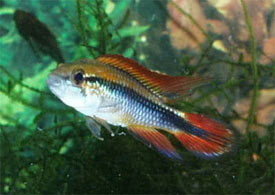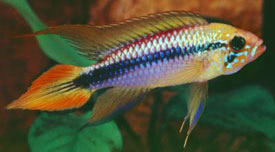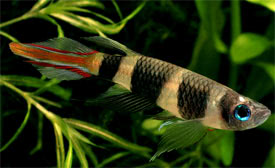
 Magyarul / Hungarian
Magyarul / Hungarian


- Scientific name: Apistogramma agassizii
- Common name: Agassiz's dwarf cichlid
- Group: Cichlids
- Habitat: South America; Found in the tributaries of the Amazon in Bolivia and Brazil.
- Size: Male: 7-8 cm; female: 5 cm
- Biotope: Inhabits shallow areas of blackwater ponds and slow-moving water with a substrateof decaying leaf litter.
- Social behavior: A peaceful, but territorial species that will not harm plants. A male forms a harem and as a result,should be kept in a ration of one male to every three or four females. Males defend a large territory in whichseveral females may guard their own brood.
- Diet: Live, crustaceans, insects, insect larvae, flakes, pellets, tablets, finely choppedmeat.
- Breeding: Quite easy
- Tank: Minimum 65 litres
- Population: 1 male and 3-4 females for 100 litres.
- Decoration: The tank should be arranged with a dark gravel bottom. Use lots of plants to serve as shelteralong with rocky caves, roots, and pieces of wood.The filter should be efficient as this species requires clean, nitrate-freewater. Agassiz's Dwarf Cichlid thrives in peat filtered water. Provide a good source of oxygen.
- Temperature: 25-26 °C
- pH: 5-7
- Hardness: 0-12 NK°
- Lifespan: 5 years
Description: An elongated with moderately compressed sides. In males, the caudal fin is highly elongatedand comes to a point.In females, the caudal fin is rounded. Several different color variations exist mostlydepending on if the fish was wild-caught or its geographical population. Males are much more colorful. Theupper back is red, while the forehead is yellow.Below these areas, the back is green which parallels a wide, horizontal,black band that extends from the tip of the snout, back through the eye, and to the tip of the caudal fin. Thelower parts, just below this band, can range in color from gold to green to blue. The belly is usually yellow. Theface is usually marked with green or gold markings.The dorsal fin is a fire orange-red color that comes to a sharp point. The other fins are often blue to green.On the caudal fin a white to blue set of lines come to a point nearthe end of the fin.A black stripe extends from the eye, down to the corner of the gill cover. Femaledo not have the elongated fins or colors of the male.They are usually yellow in color with similar markings.
Males are far more colorful and considerably larger than females. The males fins are also more elongate.
The water should have a pH from 6.0-6.5, a water hardness from 5-8 dH, and a temperaturefrom 79-84°F (26-29°C).Frequent partial water changes should be made. A single male will defend a large territorycontaining several females.He will court each female and mate with them. The female will lay up to 150 eggs ina previously cleaned cave or over-turned flower pot.The eggs will be carefully guarded by the female. They hatch in three to four days. Thefry are lead into a shallow pit and are free-swimming four to six days later. The young can be first fed with roftiersand liquid foods, and later with Artemia nauplii.The female attracts the young by her movements.



























